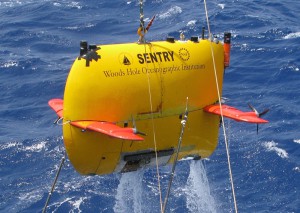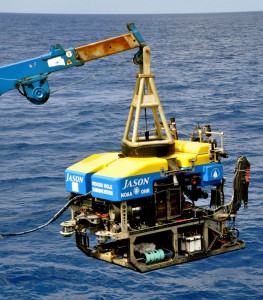 Autonomous underwater vehicle (AUV) Sentry
Autonomous underwater vehicle (AUV) Sentry
Sentry is a full autonomous underwater vehicle, meaning that it can operate completely independently of a surface ship. It is capable of operating to depths of 6000m (>19,500ft). Sentry carries a science sensor suite including a multibeam bathymetric sonar, sidescan sonar, subbottom profiler, chemical sensors, magnetometers, digital still cameras, and precise depth and attitude sensors. Sentry produces bathymetric, sidescan, subbottom, and magnetic maps of the seafloor and is capable of taking digital bottom photographs in a variety of deep-sea terrains such as mid-ocean ridges, deep-sea vents, and cold seeps at ocean margins. Sentry is uniquely able to operate in extreme terrain, including volcano calderas and scarps. Sentry‘s navigation system uses a doppler velocity log and inertial navigation system, aided by an ultra-short baseline (USBL) acoustic navigation system. The USBL system also provides acoustic communications, which can be used to obtain the vehicle state and sensor status as well as to retask the vehicle while on the bottom.
 Remotely operated vehicle (ROV) Jason
Remotely operated vehicle (ROV) Jason
Jason is a remotely operated vehicle (ROV) system designed and built by WHOI’s Deep Submergence Laboratory to allow scientists to have access to the seafloor without leaving the deck of a ship. Jason is a two-body ROV system. A reinforced fiber-optic cable delivers electrical power and commands from the ship through Medea and down to Jason, which then returns data and live video imagery. Medea serves as a shock absorber, buffering Jason from the movements of the ship, while providing lighting and a bird’s eye view of the ROV during seafloor operations. Jason is equipped with sonars, video and still imaging systems, lighting, and numerous sampling systems. Jason’s manipulator arms collect samples of rock, sediment, or marine life and place them in the vehicle’s basket or on “elevator” platforms that float heavier loads to the surface. Pilots and scientists work from a control room on the ship to monitor Jason’s instruments and video while maneuvering the vehicle. The average Jason dive lasts one to two days, though operators have kept the vehicle down for as long as seven days.








